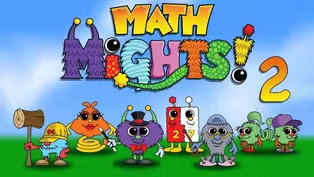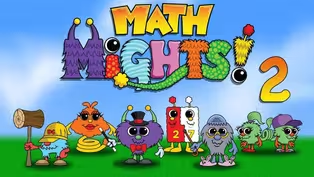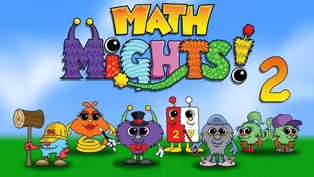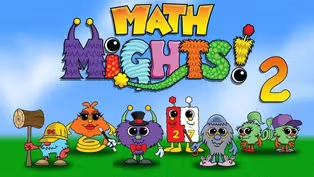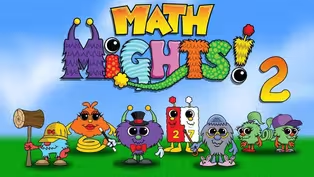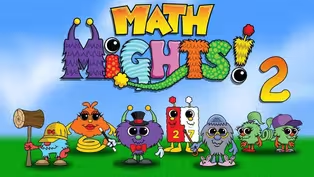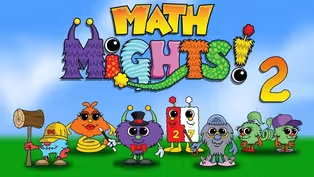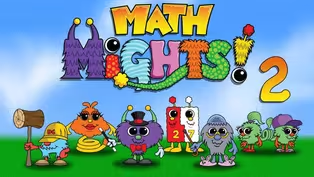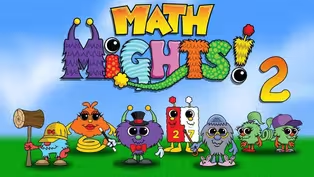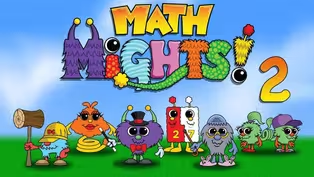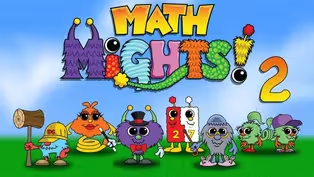Math Mights
Expanded Form
Season 3 Episode 301 | 15m 59sVideo has Closed Captions
Put numbers together and taking them apart with expanded form.
Join Mrs. McCartney to talk about numbers with Springling! Then watch out for the Value Pak as we have fun with putting numbers together and taking them apart with expanded form!
Problems playing video? | Closed Captioning Feedback
Problems playing video? | Closed Captioning Feedback
Math Mights is a local public television program presented by Detroit PBS
Math Mights
Expanded Form
Season 3 Episode 301 | 15m 59sVideo has Closed Captions
Join Mrs. McCartney to talk about numbers with Springling! Then watch out for the Value Pak as we have fun with putting numbers together and taking them apart with expanded form!
Problems playing video? | Closed Captioning Feedback
How to Watch Math Mights
Math Mights is available to stream on pbs.org and the free PBS App, available on iPhone, Apple TV, Android TV, Android smartphones, Amazon Fire TV, Amazon Fire Tablet, Roku, Samsung Smart TV, and Vizio.
Providing Support for PBS.org
Learn Moreabout PBS online sponsorshipMore from This Collection
"Math Mights" lessons for 2nd Grade students.
Video has Closed Captions
Join Mrs. McCartney for some fun with Professor Barble. (15m 59s)
Video has Closed Captions
Join Mrs. McCartney for some fun with Professor Barble. (15m 59s)
Video has Closed Captions
Join Mrs. McCartney for some fun with Professor Barble doing a tricky comparison. (15m 59s)
Video has Closed Captions
Join Mrs. McCartney for a word problem with Professor Barble that will make more sense. (15m 58s)
Video has Closed Captions
Join Mrs. McCartney for a comparison word problem with her friend Professor Barble. (15m 59s)
Compare 3-Digit Numbers Part 2
Video has Closed Captions
Join Mrs. McCartney to learn how to do a comparison word problem with Professor Barble! (15m 59s)
Comparing Numbers on a Number line
Video has Closed Captions
Join Mrs McCartney for a word problem with Professor Barble using Visula Models! (15m 59s)
Compare 3-Digit Numbers Part 1
Video has Closed Captions
Join Mrs. McCartney to see if we can figure out Professor Barble's comparison. (15m 59s)
Numbers represented in different ways
Video has Closed Captions
Representing numbers in different ways to show off your learning with place value. (15m 59s)
Video has Closed Captions
Join Mrs, McCartney for a Number Talk with her friend Springling! (15m 59s)
Video has Closed Captions
Join Mrs, McCartney for a Number Talk with her friend Springling! (16m)
Subtraction with 2-Digit Numbers Part 2
Video has Closed Captions
Join Mrs. McCartney for an addition number talk with D.C.! (16m)
Providing Support for PBS.org
Learn Moreabout PBS online sponsorship(bright upbeat music) - [Kids] Math Mights.
- Hi, second-grade Math Mights.
My name is Mrs. McCartney.
Are you ready to have some fun in math today?
Let's check out our plan for today.
We're gonna start off first with a subtraction number talk and then we're gonna do a little bit more on place value talking about expanded form.
Let's start off first with our number talk for the day.
There's three quick and easy steps to do a number talk.
I'm gonna pose a problem to you with an operation that you're familiar with.
Next, you're going to try to solve that problem mentally not using any pencil and paper, but just thinking in your mind how you would go about solving it.
Last, we're gonna share out the different strategies that you might have.
You may agree or disagree with someone else's strategy.
And remember when you're doing things mentally you might not always be accurate, but that's okay.
Let's see who our Math Might is that's gonna help us with our number talk today.
It's our springy friends, Springling.
Springling wants to help us with our number talk today.
We're getting really good at doing subtraction and being able to count up or back on a number line is a great strategy.
It's okay in this number talk if you have a different strategy or a different character that you might want to use.
Let's see what our subtraction problem is for today.
Our subtraction problem today is 58 minus 29.
Springling has that fluffy fur and the fancy eyelashes and a coily tail.
You know that she loves to count on an open number line in friendly chunks.
Are you thinking about the friendly chunks that you could use to subtract this problem?
I know that our friend has a great idea.
Nolan has solved this problem with Springling using the open number line.
He started off at the number of 29 and wanted to hop to a friendly decade number 30.
Let's check out to see how Nolan solved the problem.
He started off at 29 and ended his number line at 58.
He wants to find the distance between the two numbers.
When we hop with Springling, Nolan decided to stop at that first decade number that we would find, which is 30.
If we say hop Springling, hop, we know that it's just one.
Nolan made a really large jump next.
Sometimes in second grade, we might just want to go by tens, maybe go from 30 to 40, which is okay.
Nolan decided to go all the way up to 50 and told Springling to hop.
How far is it from 30 to 50?
We know that it's 20 if we skip count by tens.
50 to 58 is easy as we hop, we see the eight.
Springling is really competitive and she loves to count the hops that she makes on the open number line.
So let's add those numbers up together.
20 plus eight plus one gives us the answer that Nolan got, which was 29.
The hard part about number talks is you can't use pencil and paper.
And so being able to think of a strategy that you can use mentally will help you get stronger in math as a second grader.
Let's check out our I can statement for today to see what we're going to do.
I can read, write and represent three digit numbers using numbers and expanded form.
I wonder if we're gonna see our friend Value Pak today?
We're gonna start off first with playing a game of true and false.
Let's start off with our first one that we have but I think I need help from my friend Value Pak.
Here they come.
(bright upbeat music) They live in Mathville and they are a family.
When they are together, they show their value.
What better than using Value Pak as we're learning this idea about expanded form.
When they separate and go their own ways they wear their value on their belly.
So as we start to look at numbers, that's gonna help us.
I wanna find out with the Value Pak if this value that we're looking at, which is 800 plus 90 plus seven, we wanna know does that equal 897?
Let's check it out here.
So we're gonna decide if 800 plus 90 plus seven, equals 897.
I want you to visualize the idea of Value Pak being separated and then they're clicking together.
When they clicked together, they show their value.
When I put my 800, my 90 and seven together, it equaled 897.
So in fact, that is a true statement.
Jade has some thoughts about this statement.
It reads, 407 equals 70 plus 400.
Do you think that is true or false?
Jade has the thought that the number 407 has seven ones.
I wonder if this is false, let's take a look.
The number here, it says 407 is equal to 70 plus 400.
I think Jade has a great thought here because the number was 70 in it is in the tens place.
If the number is 407, we have the seven in the ones place.
And so Jade is correct that that statement is false, it should read 407 equals 400 plus seven.
You did a great job trying to figure out the different statements to see if they were true or false.
Some of them can get tricky so you have to look carefully to make sure you're understanding the value of the numbers that we're working with.
While learning about expanded form, we can remember what we've learned in the past about proportional versus non-proportional manipulatives, and we can show it in both ways.
Remember proportional manipulatives are things like base 10 blocks and Unifix Cubes.
Non-proportional manipulatives are like our place value disks, or even coins.
In this example, we're gonna first look at it with proportional manipulatives to make sure we're getting an idea of the way that numbers are working.
We have some friends that got some place value blocks and put them together.
Andre has three hundreds.
Tyler has five tens and Maya has six ones.
They wanna represent the amount they have using an equation.
Let's take a look at our blocks.
Here, we have Andre's three hundreds, over here we have Tyler's five tens.
And then over here, I have Maya's six ones.
How could we represent this in an equation?
Well, we could call on our friend Value Pak to help us to see our place value strips.
So let's start off with our hundreds.
I could use 300 to represent my three hundreds.
I could use 50 to represent my five tens, and then I could use my six to represent Maya's six ones.
So this would be, 300 plus 50 plus six.
The Value Pak separates, and then they like to click back together to show their value.
So let's put this number together to find out the value of the number.
It's 356.
I don't know about you but this is seeming easy with base 10 blocks.
I'm thinking that we should switch this over to our non-proportional manipulatives with our place value disks.
I can't do that without introducing you to one of the oldest citizens in Mathville, his name is T Pops.
(bright upbeat music) T Pops was born in Mathville a long, long time ago.
He loves doing the traditional method and he's kind of balding, he has a cane and he loves to wear bunny slippers and has these little glasses so he can see things carefully.
When we look at the non-proportional manipulatives with place value, it's important that we're using the value of the numbers.
And T Pops, although he does the traditional method in Mathville, he loves it when kids use the value of those numbers.
So we're gonna check out T Pops' place value mat that he uses with place value disks.
Let's take a look at this and see what do you notice really about his place value mat?
Do you see each of these little chalkboards?
Do those look like anything that might be familiar to you?
They actually are 10 frames, maybe from when you were in first grade, you learned a lot about 10 frames.
Why would T Pops put these in 10 frames on his mat?
Well, it helps us with the understanding of place value and it's familiar to us.
When we use non-proportional manipulatives we sometimes might want at the beginning to put the places where the place value disks go.
For example, here we have the ones and the tens and then obviously here, the hundreds.
The difference between using the proportional manipulatives versus non-proportional manipulatives is that you really don't need to write this at the top because it's displayed right on it.
If I was using the base 10 blocks, this would be two, two what?
Two tens.
Sometimes it can be confusing if you put tens here because this reads 20 tens.
So T Pops knows that second graders sometimes need the columns labeled temporarily but that's why I have it as a dry erase that I can erase it off once I know where it goes so I don't think that this is 20 tens because it's two tens.
Let's build a number on here to see if we can make it in expanded form and figure out the value by putting it on the place value mat.
Here, we have the place value disks.
What is the sums of the hundreds, tens and ones?
What is the three digit number?
I have this displayed on T Pops' place value mat.
I put this here in the hundreds place.
Cause if I counted from ones tens and the hundreds I put my tens in the 10 spot, and my ones in the ones spot.
When I was talking about this idea, it's really easy to see that this is nine because it's one less than 10.
And that's why there are those base 10 system really helps us to see that inside of the 10 frame.
So if I were to look at this and want to put this together I can see that I have one 100, nine tens and two ones.
I can also call on Value Pak to show us the value of these numbers.
We have 100 plus 90, which represents our nine tens and then two ones.
Put that together, and I have the number 192.
We could represent it with this non-proportional manipulative and show it by putting it together and by taking it apart in the expanded form which is exactly what Value Pak does.
Second grade Math Mights you are getting so smart with place value.
You're using Value Pak like a pro, being able to put it into expanded form and then showing the value.
You're able to do it with non-proportional manipulatives and proportional manipulatives.
I think it's time now that we start to play a game where we can roll three dice and then we're gonna try to create the largest number.
And then we're gonna put it into expanded form and show the three digit number that we've created.
I'm gonna go ahead and roll my three dice.
Remember, I'm looking for the highest number.
So am I gonna wanna put the ones in the hundreds place, that wouldn't make sense?
I want the highest value to be valued in the hundreds.
So I'm gonna do my five and then my three for my tens and then my one.
So let's go ahead and create this number.
The first one I have is five hundreds.
Then I'm going to build my 30, for my three tens, which is here.
And then I'm going to build my one which is really simple here.
So the total value that our dice ended up making is 531.
If I wanted to expand that and break it apart it's 500 plus 30 plus one.
This is a great game to play with a partner.
You can find out if maybe you or your partner can get the highest number.
Let's switch it up a little bit and try this with the lowest number.
Same deal, you're gonna roll the three dice, try to find out what the lowest number is that you can create, put it into expanded form, and then show that three digit number.
I'm gonna go ahead and roll the dice here.
I ended up with a six, a five and a three.
I'm trying to find the lowest number.
So would it makes sense for me to put 600?
No, because that's gonna find us the highest number.
So I'm gonna order mine with 300 here, then I'm gonna do my five, cause I think 50 is obviously less than 60 and then I'll leave that six for my ones.
We're gonna go ahead and build this number out.
So I first started off with my three hundreds which equals 300 and then I'm going to build my five tens which is equal to our 50.
And then I'm going to get my ones which is going to be six ones.
So the number that we created is 356.
If I wanted to separate this, like we do with Value Pak we can separate it by its value.
So we have 300, plus 50 plus six.
I truly feel like the place value strips are magical because you can put them together and take them apart.
And as a second grader, that makes a lot of sense for how you can think about it.
Now, it's your turn to play a game on your own called Three Digit Dash.
You're gonna be able to roll the dice and see if you can find the largest number and see if you can score a point or you also can play the other version which is, we are going to roll and see if you can find the smallest number.
I have had so much fun hanging out with you today.
I really love using Value Pak and the place value strips to help my brain think about expanded form.
I hope that you've had tons of fun and that you really have a great picture for how to take numbers together and break them apart.
I hope that you join us next time.
(upbeat music) - [Child] Sis4teachers.org.
(air whooshing) Changing the way you think about math.
- [Narrator] This program is made possible with funding from the Michigan Department of Education, Governor's Education Emergency Funds, the State of Michigan, and by viewers like you.
(bright upbeat music)


- Home and How To

Hit the road in a classic car for a tour through Great Britain with two antiques experts.












Support for PBS provided by:
Math Mights is a local public television program presented by Detroit PBS
